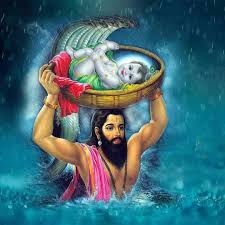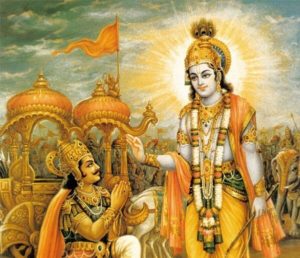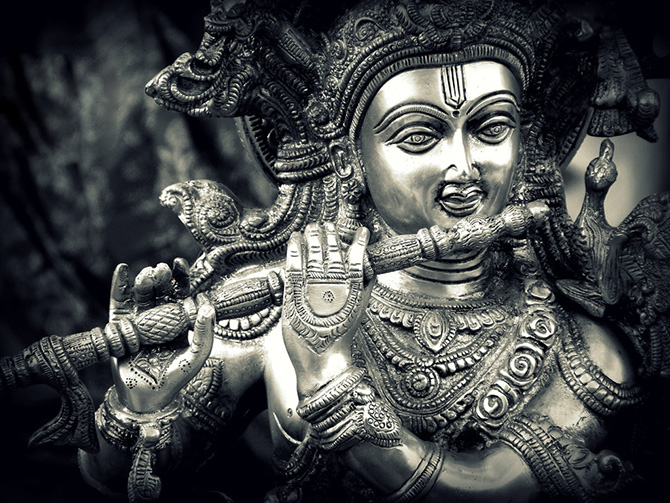According to the ancient Indian texts, Sri Krishna, is considered as the eighth incarnation of Lord Vishnu. Lord Krishna was an avatar of his era, a manifestation of God in human form!
Quoting a verse from Bhagavad Gita
परित्राणाय साधूनां विनाशाय च दुष्कृताम् ।
धर्मसंस्थापनार्थाय सम्भवामि युगे युगे
Paritranaya sadhunam vinashaya cha dushkritam.
Dharma sansthapanarthaya sambhavami yuge yuge.
Meaning:
For the upliftment of the good and virtuous, For the destruction of evil.
For the re-establishment of the natural law,I will come, in every age.
Lord Krishna is a personification of love, patience, clarity and Dharma (righteousness). Sri Krishna is remembered in Sanatana Dharma, as one who re-establishes Dharma on the planet earth, while it was moving through an absolute anarchy,a state of complete Adharma (lawlessness).
Many have confused, the reincarnations of Hindu Gods in human form, as that of a prophet. Sri Krishna became such a victim of comparison by present day philosophers and scholars. The truth that is Lord Krishna, is far from that of a prophet. Such a comparison, could have been the result of drawing a parallel of such prophets who could do mysterious things like that of Lord Krishna or it could have been an attempt to summarize and conclude the Yuga Purusha (The righteous, who is born in an era) in a simplest and easiest way.
The Sri Krishna Avatara
Sri Krishna is an incarnation of the supreme God himself, in human form. ‘Avatara’, in Sanskrit means ‘to come down’. During different yuga(era), God himself has come down to save the world from anarchy. Ancient texts like Bhagavata Purana also known as Śrīmad Bhāgavata Mahā Purāṇa says that, Sri Krishna Avatara is the paripoorna avatara of the Dasavathara (The fullest avatara or incarnation of the 10 different incarnations from the different eras).
The incarnations emanate from Lord Vishnu. Maha Vishnu is the original cause of all material creation and from him all incarnations appear.
The paradox pertaining to the avatara of Sri Krishna is that, the time he spent on this world was in Brahmavasta but he was never perplexed or confused by the turmoil happening to his life or to the world around him. Lord Krishna is also called Sachidananda, meaning one who is always happy and at ease.
Brahmavasta is Brahma-jnani.
To understand what is Brahmavasta, let us look at the Shloka 18 of Chapter 3 from Bhagavad Gita
नैव तस्य कृतेन अर्थः न अकृतेन इह कश्चन ।
न चास्य सर्व भूतेषु कश्चिद् अर्थव्यप आश्रयः ।।
Naiva tasya krutena arthah na akrutena iha kashchana I
Na chasya sarva bhuteshu kashchid arthavyapa ashryah II
It means that :
For him there is in this world, no object to acquire by doing any action; nor is there any loss, by inaction; nor has he to depend on anybody for anything.
In sleep, man is self sufficient. He has nothing to seek from any entity. But it is a negative state, based on nescience. It is temporary. The spiritually enlightened man, on the other hand, enjoys infinitude beatitude. Naught else is there for him to obtain. This BrahmAvasta is never again lost. The Brahma-jnani therefore has nothing to seek from man or God.
The reason why, Sri Krishna was unaffected by the material world was because, he is a Brahma- Jnani. Lord Krishna is Dharmaswaroopa, meaning embodiment of Dharma itself. He decides the dharma, that has to be bestowed in every situation he faced. He could decide the course of actions for the world, to move forward. The mythology has described the life of Sri Krishna, with pain, misery and happiness, like that of a common man. Through all these turmoils, Lord Krishna was never confused, sad or perplexed, as he knew what should be done the dharmic way to end the misery to further the cause of his incarnation. Even as a child Sri Krishna was always happy facing challenges that was impossible for even humans to overcome. He himself, was never a king or a prince, but a common man who did things without attachment.
To give clarity to the above statements, let us have a look at the life of Sri Rama (Another incarnation of Lord Vishnu, who was born in Treta Yuga). Sri Rama, was the incarnation of the supreme God in a fuller form. Sri Rama is also referred as ‘Adarsh Purusha’ (A role model ). Sri Rama, during his course of being in this world, had to suffer every worldly affair, Sri Rama was attached to the emotions arising out of situations and the choices he made. Despite the chaotic emotions in his life and the material world around him , Sri Rama managed to keep strict adherence to dharma as a son, a husband and an administrator of a powerful Kingdom. He had to live through all these, like a human would, trying to solve those challenges thrown at him by the world.
Every incarnation has its purpose, which has served its purpose to the fullest. Among the 10 avataras, it can be concluded that, Sri Krishna avatara is the paripoorna avatara.(The fullest avatara).
The paradox about the avatara of Sri Krishna is that, tho Sri Krishna lived in the world full of anarchy, he was never disturbed by the course of events around and he was in a constant Brahamavasta. He is a man of actions without worrying about the consequences.
Dwapara Yuga
 Sri Krishna came to the world, during the Dwapara Yuga. Dwapara Yuga is the third out of the four yugas. Dwapara Yuga follows the Treta Yuga and precedes Kali Yuga.(The current Era according to Sanatana Dharma).
Sri Krishna came to the world, during the Dwapara Yuga. Dwapara Yuga is the third out of the four yugas. Dwapara Yuga follows the Treta Yuga and precedes Kali Yuga.(The current Era according to Sanatana Dharma).
Dwapara means 2 heads. The two heads are ‘Compassion’ and ‘Truthfulness’.
 According to the Indian texts, Sri Rama had lived towards the end of the Treta Yuga and the Dwapara Yuga had started soon after his demise. This implies a period around 6676 BC , the beginning of the Saptarsi Calendar, which is a 100 years after Sri. Rama. This indicates the beginning of Dwapara Yuga. The many scientific communities has tried to get a fix, on the timeline on the events which had happened during the periods of ancient India. Such calculations are always questioned and debated.
According to the Indian texts, Sri Rama had lived towards the end of the Treta Yuga and the Dwapara Yuga had started soon after his demise. This implies a period around 6676 BC , the beginning of the Saptarsi Calendar, which is a 100 years after Sri. Rama. This indicates the beginning of Dwapara Yuga. The many scientific communities has tried to get a fix, on the timeline on the events which had happened during the periods of ancient India. Such calculations are always questioned and debated.
Historically, many significant evidences, in the forms of ruins, sculptures, texts are found to emphasize the Dwapara Yuga.
Incarnation as Sri Krishna
 Krishna, the eighth of the 10 incarnations of Vishnu (the Preserver of the Universe), is one of Hinduism’s most popular gods.
Krishna, the eighth of the 10 incarnations of Vishnu (the Preserver of the Universe), is one of Hinduism’s most popular gods.
He was born at Mathura to Vasudeva and Devaki, the cousin of the ruling King Kansa. It was prophesied that Devaki’s eighth son would kill Kansa. Kansa imprisoned Devaki and Vasudeva . He killed all her children as they were born.
However, Krishna was smuggled out of the prison and brought up as the child of the cowherd Nanda and his wife Yashoda at Gokul.
 The first three years and four months were spent at Gokula, then equal lengths of time in Vrindavan and Nandagram. At the age of eleven he left Vrindavan for Mathura where he lived for eighteen years and four months, and finally ninety-six years and eight months was spent at Dvaraka totaling about 126 years. At the time of Mahabharata, when Krishna spoke the Bhagavad-gita, He was about ninety years of age.
The first three years and four months were spent at Gokula, then equal lengths of time in Vrindavan and Nandagram. At the age of eleven he left Vrindavan for Mathura where he lived for eighteen years and four months, and finally ninety-six years and eight months was spent at Dvaraka totaling about 126 years. At the time of Mahabharata, when Krishna spoke the Bhagavad-gita, He was about ninety years of age.
Ancient Indian texts, has talked about the life of Sri Krishna, describing his valour and dharamanishta(steadiness towards the dharma), where he had fought the demons and people with evil intent, either killing them or taming them.
 By forgiving people or by punishing those who have erred in their decisions can Dharma (righteousness) be reestablished and never otherwise. The level of actions that needs to be practiced at the level of avatar is beyond comprehension of most human beings.
By forgiving people or by punishing those who have erred in their decisions can Dharma (righteousness) be reestablished and never otherwise. The level of actions that needs to be practiced at the level of avatar is beyond comprehension of most human beings.
Through his life, Lord Krishna has prescribed an excellent template for every human to follow. His central message to this world was ‘We are not called to solve the meaning of life, but to find out the deed demanded of us and to work and so, by action, to master the riddle of life’.
Sri Krishna, lived on the side of Dharma, even if it was weak. He took the the side of righteous and was there for those who trusted him. Mahabharata and life of Krishna will teach us many lessons to handle many difficult situations in life.
Lessons from the Life of Sri Krishna
![]() Spread Love, Be Humble and Generous
Spread Love, Be Humble and Generous
Lord Krishna ruled over the splendid Dwarka, a king no less. During the Kurukshetra war, donned the role of a lowly charioteer. Lord Krishna was the embodiment of simplicity and his role as a charioteer is a testament to that. Similarly, you too must be humble in your life. It helps you cultivate genuine relationships with honest people. Be generous enough to give people more reasons to be happy in their lives.
![]() A leader should stand up for his people
A leader should stand up for his people
During, his stay at Mathura, terrible rains and thunder ravaged Mathura for seven days. Lord Krishna in order to save Mathura and its people, lifted the Govardhana hill and gave shelter for them. A leader should always stand for of his people, show the path of right and be there when there is a need.
![]() Favor the side of Dharma, even if it’s weak
Favor the side of Dharma, even if it’s weak
Kaurava’s didn’t give any part of the empire to Pandavs which they rightly deserve. Duryodhana, the Kaurava king wanted all of the land. Sri Krishna stood with the Pandavas and uplifted them in every possible ways. He helped them consolidate their power by killing small enemies, making friends, and even waging war by his sheer political strategies.
![]() Don’t just work Harder, but work intelligently
Don’t just work Harder, but work intelligently
The battle of Kurukshetra was not fought with only strength or diligence, but it was fought with intelligence and strategy. A hard-working person may work for hours, completing multiple tasks but if he can manage to do so quickly with an intelligent mind, the result would come faster.
Kuchela, a classmate of Krishna was extremely poor to even afford a meal a day. Upon the advice of his wife, he comes to Dwaraka by walking to visit Sri Krishna hoping that he would help to overcome his poverty. Krishna welcomes him, respects him, changes his life by making him richer.Never forget your friends or who had helped you when you were in need. Friends are our most valuable gifts .
God is present in everything we can see around; that is why God is omnipresent.For us, the core truth lies in our spirit and this spirit is the reflection of the God.Therefore, we need to learn to trust in ourselves and this will strengthen our belief in God.
Every time we question something, we know we have the answer, and it lies within us. Our soul has all the answers to our questions. Unlike our physical self, the soul is devoid of any chaos, is calm and collected. It is our voice of reason. It will always give us the right answers. The human conscience is clean and pure and is guided by a pure light in the right direction. We need to learn to trust our conscience.
Give up temptations
We came to this world as a newborn with nothing in our possession. Nothing in this physical belongs to us in reality. It is only our Karmas that define us. Today, a child belongs to his/her parents; they will belong to their spouse and later their children. There is no constant. We need to realize that these are maya and temptations that keep us bound and tethered as our mind plays illusions, making us greedy, restless and keeping us away from our duties. Whatever we earn, build and save, will be passed onto others after we leave our bodies. We cannot take anything with us on our journey. We need to learn to let go and leave behind worldly possession to free ourselves.
Reasons for Sri Krishna Avatara
There are different interpretations, regarding the Sri Krishna Avatara. We can take 2 fundamental factors, that will be a logical explanation for the incarnation.
As a means to understand Parabrahma
Parabrahma, is beyond explanation. Words can only describe the Prakruti (that you see), but the parabrahma is beyond the description by words. ‘Para’ is a Sanskrit word that means “higher” in some contexts, and “highest or supreme” in others. ‘Brahman’ connotes the Highest Universal Principle in Hinduism, the Ultimate Reality in the universe
Sri Krishna with his actions in this world acted as a conduit for commoners to understand the concept of Parabrahma.
As a means summarize all the Upanishads
It was during the end of Dwapara Yuga that, Sri. Krishna gave Bhagavad Gita to the world. Bhagavad-Gita of Hinduism is the doctrine given to mankind which with passage of time becomes the ultimate truth as nothing in Bhagavad Gita becomes redundant. At any given moment of time all principles laid out in Bhagavad Gita withstand the truths of time.
 Bhagavad Gita, is the holy grail for the current Era, the Kali Yuga. The Bhagavad-Gita is presented as a conversation between Arjuna, a supernaturally gifted warrior about to go into battle during the Dwapara Yuga. Lord Krishna, was his charioteer. In the course of giving Arjuna all manner of spiritual and material advice, Krishna explains karma, the self, the Supreme Self, the purpose of yoga, the difference between our self and our material body, how our environment affects our consciousness, and how to attain the perfection of life.
Bhagavad Gita, is the holy grail for the current Era, the Kali Yuga. The Bhagavad-Gita is presented as a conversation between Arjuna, a supernaturally gifted warrior about to go into battle during the Dwapara Yuga. Lord Krishna, was his charioteer. In the course of giving Arjuna all manner of spiritual and material advice, Krishna explains karma, the self, the Supreme Self, the purpose of yoga, the difference between our self and our material body, how our environment affects our consciousness, and how to attain the perfection of life.
We can say that, towards the end of Dwapara Yuga, Sri Krishna summarized all the Upanishads in this world. The Upanishads are the sections of the Vedas that deal with philosophical knowledge, and are considered the cream of the Vedas. Summarizing all the Upanishads, Sri Krishna gave the ultimate knowledge, to the world through Bhagavad Gita.
The text Mahabharata mentions that the Dwapara Yuga ended and the Kali Yuga started as soon as Sri. Krishna left this world; and then the seas swelled up and submerged the island-city of Dwarka, which was located off the coast of western India.
https://www.youtube.com/watch?v=lF8aMBGLzlM
Source:.booksfact
Image Courtesy:GoUNESCO
You may also like
-
PM Launches the Kindle Version of Swami Chidbhavanandaji’s Bhagavad Gita
-
PM Releases Manuscript with Commentaries by 21 Scholars on Shlokas of Srimad Bhagavadgita
-
Gita, A Military Manual, Should Be Read By All, Says Maj Gen Sharan
-
PM Modi Unveils ‘Astounding’ 800-Kg Bhagavad Gita
-
Bhagavad Gita – Understanding Kurukshetra War
